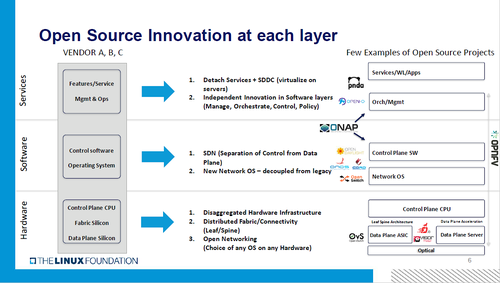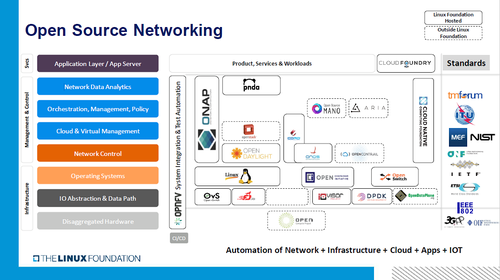|
|
|
Contributors | Messages | Polls | Resources |
|
Linux Foundation's Joshipura on Building Open Enterprise Cloud Enterprise cloud enablement, like any digital-transformation initiative, doesn't happen in a vacuum. Network components, competing standards and old and new technologies have to work together; likewise for organizations. Enter Arpit Joshipura -- a relative newcomer to the Linux Foundation. As general manager for the Linux Foundation's networking and orchestration efforts, Joshipura's job involves leveraging open-source investment to unite the disparate components and companies involved in digital-transformation technologies. Telco Transformation asked Joshipura about his perspective on enterprise cloud trends. In Part 1 of this Q&A series -- edited for length and clarity -- he addresses enterprise cloud in the context of open source, which is the bread and butter of the Linux Foundation. Joshipura particularly emphasizes the importance of "harmonizing" open-source technologies with proprietary solutions on the way to enterprise cloud transformation. In Part II, Joshipura talks about enterprise cloud's role in enabling automation technologies -- in particular, AI and big data analytics -- across 5G networks.
Telco Transformation: How do you and how does the Linux Foundation see the role of open standards and open source in the evolution of enterprise cloud? Arpit Joshipura: One of the primary reasons I was hired at the Linux Foundation was to lead the entire networking-organization initiative across the industry. I've been in the networking industry for 30 years, and a couple of things happened in the last several decades. From proprietary we have moved to a whole set of open-source components. We've got an ecosystem that's rich in several open-source standards, as well as we have the traditional open-source components and open-source standards that are applicable at each layer of the network. With that background, I would say the most important thing for the industry right now is to understand the role of both [proprietary and open source] and make sure that they are complementary.
Layers

Arpit Joshipura: "Open-source components and open standards are sitting side by side, so that you can see at various layers of the network the applicability."
For the enterprise, what we are starting to see is a lot of convergence starting from the lowest layer of disaggregation. We're starting to see alignment of open source and open standards…Standards, how hardware is built and how software is built all kind of come together in a harmonized world, and this disaggregated trend is what enterprises are using to build their datacenters of the future. TT: Does introducing virtualization early and on-premises make the process of "harmonization" easier? Or is it easier or more efficacious to wait until the enterprise network has graduated to an enterprise cloud environment before introducing the layers of virtualization? AJ: That's an excellent question and the way I look at it, and I've seen enterprises evolve, is that the order in which things get virtualized is very dependent on the business they are in. But at the highest level, the first things that get virtualized are the servers. That's where the hypervisor come in; this is where the virtual compute happens, and the VMs are a way to do it. Immediately following that, now that you have so many VMs sprinkled in the data center, your network does not keep up with physical switches. So the next thing you do is you do a virtual network, or network virtualization. When you do network virtualization, whether it's an overlay network or an underlay network, you've got the ability to reach different parts of your datacenter with east-west traffic, minimal latency, etc. What you do then is get to storage virtualization, and when you have that you have a software-defined datacenter. That to me is the first phase of how enterprises are taking a stab at the next generation of cloud. Now while you're doing that, there is also a parallel effort where some of the implementation of this journey happens to be on-premises and some of this happens to be in a public cloud, leading to more of a hybrid cloud or "enterprise cloud." This is in a traditional large enterprise that has been in the business for quite some time. If you take a brand new enterprise, a startup or a small business that is just coming out of funding or a startup like that, they would start from the public cloud day one. They would not put anything on-premises. As they grow, they would get to a point where on-premises clouds are much cheaper, and that's a function of their workloads and how big they are and all that. But for the rest of the companies, you typically start with virtualization, and then the cloud comes next. People equate virtualization with cloud, and that's not the case. TT: Your role with the Linux Foundation is a relatively nascent one. (See Linux Foundation's Joshipura Brings Order to Open Source.) Where would you say this new role and what you've been working on fits in with enabling enterprise-cloud digital transformation at the carrier and network-operator level? AJ: The Linux Foundation, as you know, is a non-profit, and we are host to the world's largest shared technology investment open-source project. So we are kind of sitting here as a neutral entity between enterprises and carriers and between end users and cloud. We are sort of sitting right in the middle of all three of what I call the big bucket markets; the cloud market, the enterprise market and the carrier market. This role helps us look at it from a broader perspective of what's happening within each category. How are enterprises using carrier technology? How are carriers trying to support the enterprises? We have governance -- a board of directors from some of the top carriers, some of the top enterprises, some of the top cloud service providers that we have been able to work with within the community and the governance structure, and provide a lot of thought leadership on where things are heading. So that's kind of how I see myself, and I'm very privileged to be in this role because it requires me to be facilitating the community across some of the most visible senior management that exists in the networking space.
— Joe Stanganelli, Contributing Writer, Telco Transformation |
In part two of this Q&A, the carrier's group head of network virtualization, SDN and NFV calls on vendors to move faster and lead the cloudification charge.
It's time to focus on cloudification instead, Fran Heeran, the group head of Network Virtualization, SDN and NFV at Vodafone, says.
5G must coexist with LTE, 3G and a host of technologies that will ride on top of it, says Arnaud Vamparys, Orange Network Labs' senior vice president for radio networks.
The OpenStack Foundation's Ildiko Vancsa suggests that 5G readiness means never abandoning telco applications and infrastructures once they're 'cloudy enough.'
IDC's John Delaney talks about how telecom CIOs are addressing the relationship between 5G, automation and virtualization, while cautioning that they might be forgetting the basics.
 On-the-Air Thursdays Digital Audio On-the-Air Thursdays Digital AudioARCHIVED | December 7, 2017, 12pm EST
Orange has been one of the leading proponents of SDN and NFV. In this Telco Transformation radio show, Orange's John Isch provides some perspective on his company's NFV/SDN journey.
 Special Huawei Video Special Huawei VideoHuawei Network Transformation Seminar The adoption of virtualization technology and cloud architectures by telecom network operators is now well underway but there is still a long way to go before the transition to an era of Network Functions Cloudification (NFC) is complete. |
|
|
|
||



















